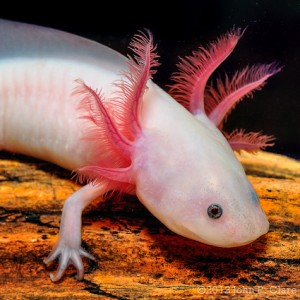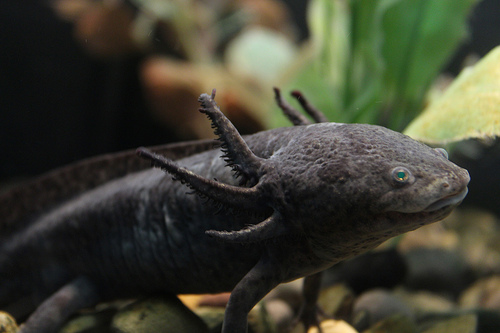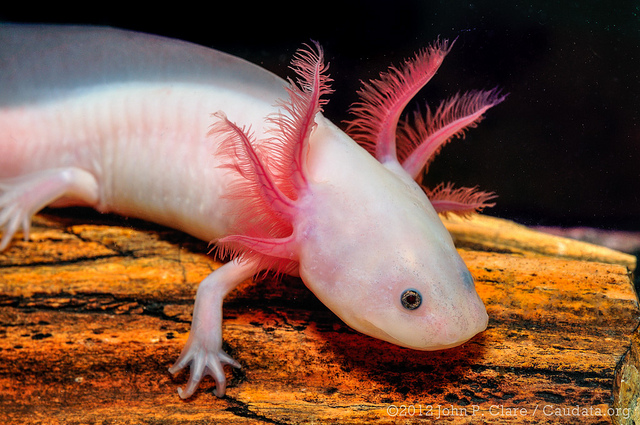The Axolotl Salamander (Ambystoma mexicanum) (pronounced ACK-suh-LAH-tuhl) is a medium-sized amphibian that is native to lakes close to Mexico City. It is most closely related to the tiger salamander which inhabits the waters in a similar region of Mexico. It is also known as the Mexican Walking Fish, although it is an amphibian, not a fish.
Axolotl Biology
The Axolotl is neotenic, which means that they reach adulthood without undergoing metamorphosis. They do not go from larval to an adult form. Instead of developing lungs and taking to land, the adults remain aquatic and gilled. The gilled larval form becomes sexually mature and reproduces. Axolotl salamanders live their entire lives in water, never emerging onto land.
Axolotl salamanders have a flat-shaped, broad, head that is much wider than the body. They have feathery gills which protrude from either side of the head, allowing the axolotl to breathe underwater. Axolotls are able to regenerate limbs that become damaged or detached from their bodies. Most axolotls reach about 10 inches total in length, from the tip of the nose to the end of the tail.
RELATED:
Freaky Suriname Toad Birth, a Trypophobic’s Worst Nightmare
Axolotls have been known to live past 20 years, but it is unusual to find an individual older than 10 years.
The axolotl salamander is most commonly found in albino form as they spend a lot of their lives hiding under rocks and in crevices on the bottom of the lake. Although axolotls are generally white or pink in color, black, grey and brown colored axolotls can also be found.

The axolotl salamander is a carnivorous animal. It will eat worms and insect larvae that develop under the surface of the water, along with mollusks, crustaceans and some small species of fish.
Due to the bottom-dwelling lifestyle of the axolotl, it has surprisingly few natural predators. Birds and large fish are the most common predators of the axolotl along with humans who catch the axolotl to keep as pets in artificial environments.
The axolotl salamander can live for up to 25 years, although the average axolotl rarely gets much older than 15 years of age. Females can lay anywhere from 100 to 1,000 eggs. These eggs are coated with a sticky substance that helps them to stick to plants and rocks in the water to keep them safe. After about a month of development, tiny axolotl babies emerge into the open water.

Axolotl Salamanders in Captivity
Some axolotl salamanders are available as freshwater aquarium pets from breeders but they may be difficult to come by. They are a hardy creature can be expected to live up to 10-15 years with attention to proper care, particularly with respect to water quality. Their skin and gills are very sensitive and quite soft, so handling is not recommended.
Axolotl Care Sheet:
Expert Guide on Housing, Feeding, & Breeding
Axolotl Salamanders Status
Fairly recent urbanization in Mexico City and its consequent water pollution is the most destructive factor in the survival to the axolotl. Axolotls have been used extensively in scientific research due to their ability to regenerate limbs. Axolotls were also sold as food in Mexican markets.
Since 2010, axolotl salamanders are currently listed by CITES as an endangered species and by IUCN as critically endangered in the wild.
A four-month-long search in 2013 turned up no surviving individuals in the wild.
A is for Axolotl Salamander: A-Z Collection of Animals #reptiles Click To Tweet
- Mindful Travel With Your Dog This Holiday Season - December 23, 2019
- A-Z of Australia’s Endangered Wildlife - December 20, 2019
- Teaching Your Kids How to Walk the Dog Safely - December 2, 2019


i caught one of these amazing creatures just last week in colorado, then saw more in the water. really cool find apparently .
That’s cool, Dan. What did you do with it?
i put it right back in the lake. knew it had to be a something rare and special as is the beautiful lake of lillly pads it lived in. happy to know what it is called now.
Oh, good. Glad to hear that, although I wouldn’t have blamed you for wanting to keep it. People do have them for pets, but I would imagine it’s needs are specialized. I’m glad you know what it’s called now. Thanks for reading my post. All the best. 🙂
Very interesting and such a long life span.
Hello! Thanks for stopping by! It really is an odd creatures, isn’t it? I love sharing this kind of thing. Come back soon, ya hear? 🙂
I’ve never heard of “neotenic” before. What an exotic and interesting creature.
It really is an exotic and interesting creature. I’m glad you learned a new word! Thanks so much for stopping by! I’ll go check out your C is for Cheesy post now. Have fun with the A-Z Challenge. Incidently, I just started a Pinterest Group Board for the A-Z Challenge. Every topic, every theme welcome! I you’re interested in joining us in a group share, email me at jeanne@animalbliss.com with your Pinterest name or email. Thanks! 🙂
You know I love everything with VIDEOS!! I find videos the most informative and sometimes creepy things there are. But I learn the most about our environment and how animals function in the ecosystem this way. SO i was very very appreciative for the video. Amazing. Cant wait for tomorrows!
Danielle
Thanks, Danielle. I do appreciate your visits and your many kind comments. Yes, I enjoy videos too. I try to find interesting, relatively short ones, for those of us with short attention spans. 🙂 Take care!
Mexican Waking Fish? What will we see next? If you live long enough, you can definitely see some interesting things. Cute little critters. Thanks Jeanne!
You’re welcome, Rory. I’m glad you’ve learned something new! That’s why I love what I do. 🙂
Hello, I’m visiting from the A-Z Blogging Challenge. Very interesting post. I was not familiar with the Axolotl Salamander…until now! So sad that there are so few left in the world 🙁
I’m really glad you stopped by, Marie. I love it when fellow animal bloggers stop by. I’ll go have a look at your post now. Come back soon! And have fun with the challenge!
What a strange creature! I think I’d squeal if I came across it, just because of the things around its neck. Odd, odd.
Happy A Day!
~AJ Lauer
an A-Z Cohost
@ayjaylauer on Twitter
Squealing is good. It clears the lungs so you can squeal with joy at some other thing. 🙂 Thanks so much for stopping by. I really appreciate you, AJ.
I love salamanders and lizards! Blue-tailed skinks are my favorite animal in all the world, for some reason. lol
Looking forward to your posts. 🙂
I’m glad to meet a fellow salamander and lizard-lover. I have a Bearded Dragon named Shirley, who you’d love too. I’ll do some research on the blue-tailed skink and so a post on that some time. Thanks for the idea. Take care. Have fun with the Challenge. I’ll go visit your site now. 🙂
Wow, what a cool looking little guy! I love the little things coming out of their necks.
Good luck with the 2015 A to Z Challenge!
A to Z Co-Host S. L. Hennessy
http://pensuasion.blogspot.com
Glad to have you visit my site today, S.L. It is rather a cool looking little critter, isn’t it? Hey, have fun with the challenge too! I’ll stop by and visit your site too! 🙂 Peace
I learned something new today, yay 🙂 Stopping in from the A-Z Challenge, hope you have a lot of fun with the challenge this month!
Hey, I’m glad you stopped by, Sara! I’m really looking forward to this challenge. I’ll head on over to your site now and check you out too! I love Apples n’ Cinnamon! 🙂